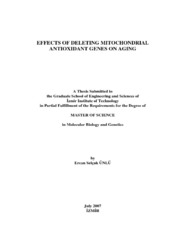Please use this identifier to cite or link to this item:
https://hdl.handle.net/11147/4016| Title: | Effects of Deleting Mitochondrial Antioxidant Genes on Aging | Authors: | Ünlü, Ercan Selçuk | Advisors: | Koç, Ahmet | Publisher: | Izmir Institute of Technology | Abstract: | Reactive oxygen species (ROS) damage biomolecules, accelerate aging, and shorten life span, whereas antioxidant enzymes mitigate these effects. Because mitochondria are a primary site of ROS generation and also a primary target of ROS attack, they have become a major focus area of aging studies. Here, we employed yeast genetics to identify mitochondrial antioxidant genes that are important for replicative life span. We found that among the known mitochondrial antioxidant genes (TTR1, CCP1, SOD1, GLO4, TRR2, TRX3, CCS1, SOD2, GRX5, PRX1), deletion SOD1 (Cu, Zn superoxide dismutase), SOD2 (Manganese-containing superoxide dismutase), and CCS1 (Copper chaperone), shortened the life span enormously under normal conditions. The life span decreased 40% for sod1 mutant, 72% for sod2 mutant, and 50% for ccs1 mutant. When a respiratory carbon source was used in addition to sod1, sod2 and ccs1, deletion of CCP1 (cytocrome c peroxidase) also lead to a decrease in life span which decreased% 79 for sod1 mutant, 87 % for sod2 mutant, 51 % for ccs1 and65 % for ccp1 mutant. Deletion of the other genes had little or no effect on life span for both conditions. To further investigate the role of these antioxidant genes molecular damages on lipids, proteins, and DNA were detected in mutants. The results showed that level of lipid peroxidation was usually lower when cells were grown under normal conditions. If cells were grown in respiratory substrate glycerol, deletion of CCS1, SOD2, GRX2, CCP1, TRR2 and PRX1 genes increased cellular lipid peroxidation levels by 87%, 73%, 65, 48%, 30% and 16% respectively. Protein carbonylation levels were 34% higher for ccp1 and 87% higher for grx2 mutants compared to WT cells when the cells were grown under normal conditions. However, it increased 65% for ccs1, 61% for prx1, 57% for glo4, 55% for ccp1, 49% for sod1, 37% for sod2, 33% for grx2, 18% for trx3, 17% for grx5 and 7% for trr2 when the cells were grown in the presence of glycerol. Q-PCR assay showed that deletion of CCS1 and PRX1 lead to DNA damages in mitochondrial DNA. Our overall results showed that some of the antioxidant mitochondrial mutants lived shorter and accumulated extensive molecular damages in the presence of respiratory carbon source. | Description: | Thesis (Master)--Izmir Institute of Technology, Molecular Biology and Genetics, Izmir, 2007 Includes bibliographical references (leaves: 36-40) Text in English; Abstract: Turkish and English x, 43 leaves |
URI: | http://hdl.handle.net/11147/4016 |
| Appears in Collections: | Master Degree / Yüksek Lisans Tezleri |
Files in This Item:
| File | Description | Size | Format | |
|---|---|---|---|---|
| T000644.pdf | MasterThesis | 406.52 kB | Adobe PDF |  View/Open |
CORE Recommender
Items in GCRIS Repository are protected by copyright, with all rights reserved, unless otherwise indicated.